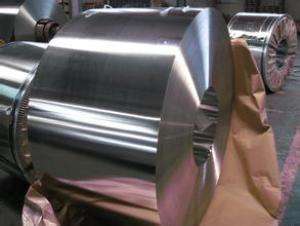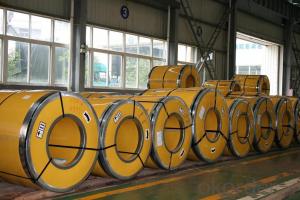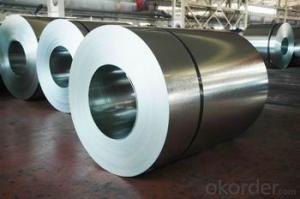Hot Dip Galvanized Steel Coil in coil
- Loading Port:
- Shanghai
- Payment Terms:
- TT OR LC
- Min Order Qty:
- 25 m.t.
- Supply Capability:
- 2500 m.t./month
OKorder Service Pledge
OKorder Financial Service
You Might Also Like
Hot Dip Galvanized Steel in Coil
Description:
Galvanized Steel Coil gets coated in layers of zinc because rust won't attack this protective metal. The most external layer is all zinc, but successive layers are a mixture of zinc and iron, with an interior of pure steel. These multiple layers are responsible for the amazing property of the metal to withstand corrosion-inducing circumstances. Zinc also protects the steel by acting as a "sacrificial layer." If rust does take hold on the surface of Superiority:
1. Good Resistance to Corrosion
2. Qualified Processing Machinability
3. High Thermal Resistance
4. Excellent Reflectivity
5. Inexpensive and effective enough
6. Can be recycled and reused multiple times
Application:
1. Architecture Roofs and outside walls of civilian and industrial buildings, garage doors, fencings and window blinds
2. Appliances Industry Outer clad sheets for washing machine, refrigerator, television, air conditioner and ventilation system, explosion-proof strip, solar water heater and appliance parts
3. Auto Industry Muffler, heat shields of exhaust pipe and catalytic converter, auto parts & accessories under the frame, signboard in highway
4. Industrial Instruments Electric control cabinet, industrial refrigeration equipment, automatic vending machine
Product Specification:
Material:SGCC,DX51D,Q195
Thickness: 0.3-3.0mm
Width: 600-1500mm
Inner Diameter: 508mm, 610mm
Weight of Steel Coil: 3-15MT
Coating Type: Al-Zn Alloy
Available Dipped Layer: 50-150g/m2
Surface Finish Structure: Normal Spangle & Small Spangle & Zero Spangle
Spangle: normal spangle, large spangle, small(min) spangle, zero spangle
FAQ:
1.How about the package for the Hot Dip Galvanized Steel in Coil?
Usually Standard export seaworthy package: waterproof paper+steel trip packed+wooden case seaworthy package
2. Can I know the production period of the goods?
Usually it need 20 days for 25tons in one container. We can produce 300 tons per day but we need to arrange the production in advance.
3. How about the label, could you make the label according to pour requirements?
Usually we use the MILL label, but if you need special form we can make.
- Q: What are the different types of steel coil packaging materials used during processing?
- There are several different types of steel coil packaging materials used during processing, including steel strapping, plastic strapping, stretch film, corner protectors, edge protectors, and wooden crates.
- Q: How do steel coil manufacturers stay updated with industry trends?
- Steel coil manufacturers stay updated with industry trends through various methods: 1. Industry conferences and trade shows: Manufacturers attend industry-specific conferences and trade shows where they can network with other professionals, attend seminars and presentations, and learn about the latest trends and innovations in the steel coil industry. 2. Industry publications and magazines: Manufacturers subscribe to industry publications and magazines that provide regular updates on trends, market insights, and technological advancements in the steel coil industry. These publications often feature articles and interviews with experts, providing valuable information to stay updated. 3. Online resources and forums: Manufacturers stay connected with the industry by actively participating in online forums, discussion boards, and social media groups focused on steel coil manufacturing. These platforms allow them to engage with peers, share knowledge, ask questions, and stay updated on the latest trends. 4. Collaboration with suppliers and customers: Manufacturers maintain close relationships with their suppliers and customers. By regularly communicating with them, they can gain insights into changing market demands, new product requirements, and emerging trends. Suppliers and customers often share information about industry trends and advancements that can help manufacturers adapt their processes accordingly. 5. Continuous education and training: Manufacturers invest in continuous education and training programs for their employees. These programs aim to keep the workforce updated on the latest industry trends, technological advancements, and best practices. By prioritizing employee development, manufacturers ensure they have the skills and knowledge to stay ahead of the curve. 6. Research and development: Steel coil manufacturers allocate resources for research and development activities to explore new materials, manufacturing techniques, and technologies. By investing in R&D, manufacturers can stay at the forefront of industry trends and develop innovative solutions that meet evolving customer demands. 7. Government and industry regulations: Manufacturers stay updated with government regulations, industry standards, and certifications that impact the steel coil industry. Compliance with these regulations often necessitates manufacturers to adopt new practices, technologies, or materials, ensuring that they stay up to date with the latest trends and requirements. By actively engaging in these activities, steel coil manufacturers can stay informed about industry trends, emerging technologies, and market demands. This allows them to adapt their processes, products, and strategies to remain competitive and meet the evolving needs of their customers.
- Q: How are steel coils coated for specific applications?
- Steel coils can be coated for specific applications through various methods such as hot-dip galvanizing, electro-galvanizing, or applying organic coatings like paints or lacquers. These processes help enhance the steel's corrosion resistance, improve its appearance, and provide specific properties required for different applications.
- Q: How are steel coils used in the manufacturing of automotive wheels?
- Steel coils are used in the manufacturing of automotive wheels as a primary material for the wheel rims. The steel coils are shaped, cut, and welded to create the desired size and design of the wheel rim. They provide high strength and durability, ensuring the wheels can withstand the weight of the vehicle and the impact of road conditions.
- Q: What are the common methods of storing steel coils in warehouses?
- There are several common methods for storing steel coils in warehouses, depending on the size and weight of the coils, as well as the available space and resources in the warehouse. Here are some of the most commonly used methods: 1. Block stacking: This method involves stacking the steel coils directly on top of each other, forming a block. The coils are typically aligned in rows and columns, with wood or rubber blocks placed between the layers to provide stability and prevent damage. 2. Racking systems: Racks are often used to store steel coils in warehouses. There are various types of racks, including cantilever racks, coil racks, and structural racks. These racks provide a structured system for organizing and storing the coils, allowing for easy access and efficient use of space. 3. Coil cradles: Coil cradles are a type of storage equipment specifically designed for steel coils. They consist of a series of cradles or saddles that securely hold the coils in place. These cradles can be stacked on top of each other to maximize vertical space utilization. 4. Coil pads: Coil pads are flat platforms made from materials such as wood, rubber, or foam. They are placed on the warehouse floor, and the steel coils are then stacked directly on top of them. Coil pads help to distribute the weight of the coils evenly and protect them from damage caused by contact with the floor. 5. Slit coil storage: Slit coils, which are narrower and lighter than full-size coils, can be stored using specialized storage systems. These systems often consist of racks or shelves equipped with dividers or separators to keep the coils organized and prevent them from unraveling. It is important to note that regardless of the storage method used, safety precautions should be followed when handling and storing steel coils in warehouses. This includes ensuring proper weight distribution, using appropriate lifting equipment, and adhering to industry-specific guidelines and regulations.
- Q: What are the different types of steel finishes available for coils?
- There are several types of steel finishes available for coils, including hot rolled, cold rolled, galvanized, and coated finishes.
- Q: What are the main steel coil producing countries?
- The main steel coil producing countries are China, Japan, India, the United States, and Russia.
- Q: How are steel coils used in the production of construction equipment?
- Steel coils are used in the production of construction equipment as they are a crucial raw material for manufacturing various components such as frames, beams, plates, and structural parts. These coils are processed through cutting, bending, and welding techniques to form the required shapes and structures used in the construction industry.
- Q: How do steel coils contribute to the manufacturing of HVAC systems?
- Steel coils are used in the manufacturing of HVAC systems primarily for their strength and durability. They form the core structure of various components such as heat exchangers, condenser coils, and evaporator coils. The steel coils provide stability and support, ensuring the longevity and efficiency of HVAC systems by withstanding high temperatures, pressure, and constant use.
- Q: With the Reduced weight of steel,wouldn't the projectile be at a much higher velocity when fired causing more damage?I mean l couldn't steel be worked to seal the bore,not damage the rifling and still cheap enough to mass produce,and be light enough to carry much more ammo.
- Well trying to force that down a rifled barrel would be a funny trick. Please have a friend or two there to record it so they can put the blowing up of your rifle on youtube so people can learn what happens when idiots try stupid things. I'd say you should but you'll likely be dead or in hospital from the injuries. To expand your knowledge: Until you get to NIJ class 3 body armor any lead core high velocity bullet of FMJ form will go through like it's not even there. Oh pretty much anything with soft point ammunition at over 2,000fps velocity will go through with devastating effect. So lets see .. oh yes time to ban the .30-30 Winchester for civilian use. All the typical rifle caliber ammunition designated by the military as armor piercing has a copper alloy jacket around either a hardened steel core or more commonly a lead core with a hardened steel or tungsten alloy penetrator centered in that.
Send your message to us
Hot Dip Galvanized Steel Coil in coil
- Loading Port:
- Shanghai
- Payment Terms:
- TT OR LC
- Min Order Qty:
- 25 m.t.
- Supply Capability:
- 2500 m.t./month
OKorder Service Pledge
OKorder Financial Service
Similar products
Hot products
Hot Searches
Related keywords




























